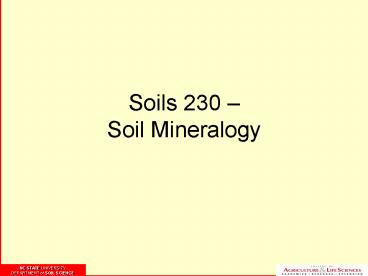Soils 230 Soil Mineralogy - PowerPoint PPT Presentation
1 / 54
Title:
Soils 230 Soil Mineralogy
Description:
DEPARTMENT of SOIL SCIENCE. Soils 230. Soil Mineralogy. NC STATE ... Field Excercise. NC STATE UNIVERSITY. DEPARTMENT of SOIL SCIENCE. NC STATE UNIVERSITY ... – PowerPoint PPT presentation
Number of Views:1657
Avg rating:3.0/5.0
Title: Soils 230 Soil Mineralogy
1
Soils 230 Soil Mineralogy
2
Overview
- Introduction
- Clay Mineralogy
- Landscape and Site
- Laboratory Methods
- Field Methods
- Rule .1941 a3
- Soil Taxonomy
- Example Tale of Two Soils
- Lab exercise
- Field Excercise
3
Introduction
- Why do we care?
4
Clay Mineralogy Why is it important?
- The minerals in the clay-sized fraction of the
soil affects the degree to which soils shrink
(when dry) and swell (when wetted). - As a clay soil swells the amount and size of pore
space decreases and affects the ability to move
water (effluent) through the soil.
5
Hydraulic conductivity decline from wastewater
6
Infiltration rate decline from wastewater
INFILTRATION RATE (cm/h)
LAUNDRY
TIME (h)
7
Why does this happen?
- Change in cations in solution
- Disperse some clay
- Clogs pores
- Result in swelling of some clay
- Closes pores
8
Expansive clay in thin section
- Bright colors due to the clay being oriented.
- Orientation due to stress (shrink-swell)
- Porosity limited
4 mm
9
Nonexpansive clay in thin section
- Less oriented clay
- Voids outlines with clay skins (argillans)
4 mm
10
Mixed clay in thin section
- Less oriented clay
- Thin argillans
- High iron content
4 mm
11
Expansive clay low hydraulic conductivity
micropore network
(Borchardt, 1986)
12
Introduction to Clay Minerals
- Alan Clapp, Dean Hesterberg, and David Lindbo
- Orange Co. Health Department
- Dept. of Soil Science, NC State
13
Outline
- Building blocks
- Classification
- Properties
- Identification
- Formation
14
Building Blocks of Clay
- Silica Tetrahedron-four sides, four oxygen
molecules and one silica (Si4) - Aluminum Octahedron-eight sides, six oxygen
molecules and one Al3 - These are bound together by shared oxygen
molecules into different layers
15
Tetrahedron and Octahedron
16
Clay Minerals
- Layer(s) of linked Si tetrahedra
- Layer(s) of Al octahedra
17
Sheets of Tetrahedron and Octahedron
18
Definitions
- Plane-plane of atoms, individual row in the
composition and structure of the clay mineral - Sheet-combination of planes
- Layer- combination of sheets i.e.. 11
19
Clay Mineral Classification
- 11 Clay Minerals
- 21 Clay Minerals
- Mixed Mineralogy
20
Clay Structure
21
11 Clay Minerals
- Like an open face sandwich
- One silica tetrahedron (bread)
- One aluminum octahedron (filling)
- The most common 11 minerals is Kaolinite
22
11 Clay Mineral
23
11 Clay MineralsCEC 7 meq/100 gnon-expanding
24
21 Clay Minerals
- Like a sandwich with two slices of bread
- Two silica tetrahedrons (bread)
- One aluminum octahedron (filling)
- The 21 clays can be broken into 2 groups
- Expansive
- Non expansive
25
21 Clay Mineral
26
21 Clay MineralsCEC 40 meq/100 gnon-expanding
27
Non-expansive 21 Clays
- the sheets or layers are held together strongly
- neither water nor a change in the interlayer
cations causes them to swell - Illites are one group of non-expandable clays
28
Expansive 21 Clays
- Bound together by very weak hydrogen bounds
(easily broken) - Will swell upon wetting
- Smectites (montmorillonite) are one group of
expandable clays
29
21 Clay Minerals (expanding)CEC 100 200
meq/100 g (vermiculite) 70 120 meq/100 g
(smectite)
30
(No Transcript)
31
Properties
- Surface Area
- Cation Exchange Capacity
- Expansion
32
Surface Area
- Smectite group minerals have higher CEC
- Smectite group minerals have a higher surface
area - Isomorphic substitutions plays a role in the
above and in the expansive nature of this group
33
Selected Properties
34
Why water causes the mineral to expand
- Water is dipolar- which simply means it can be
attracted to a net negative charge or a net
positive charge - Water carries many different ions in soil
solution - Water has a physical size
35
11 Nonexpansive
Strong H-bonds
36
21 Non-expanding
K interlayer
37
Hydroxy-interlayered Vermiculite
Al-hydroxy- interlayer
38
21 expandable
Exchangeable Cations
Weak H-bonds
39
21 expandable
Hydration of Cations
40
Soil mineralogy and consistence
- Clay mineralogy
- Water movement
- Management
- Consistence
- Field method to relate soil properties to clay
mineralogy
41
Identification
- Layer spacing
- X-ray diffraction
- Expansive properties
42
Layer Spacing
43
Bragg's Law
44
(No Transcript)
45
X-Ray Diffraction
Quartz
Kaolinite
HIV
46
X-Ray Diffraction
Quartz
Illite
Kaolinite
Smectite
47
Formation
- Parent material
- Weathering
48
Typical Weathering Sequence
- Poorly drained conditions (slow water movement)
- H4SiO40 dissolves from primary minerals
- Accumulates is soil
- Favors 21 clay formation (smectite)
- Well drained conditions (high rainfall)
- H4SiO40 leaches through profile
- Bases leach through profile (more acid)
- Favors 21 illite/vermiculite to 11 kaolinite
to gibbsite
49
(No Transcript)
50
Jackson-Sherman Weathering Stages
51
Selected Mineral Transformations
- Ca2
H4SiO40
Ca2
- K
52
Weathering Pathways
Noncrystaline hydrous oxides of Si, Al, Fe and Ti
Olivine Pyroxene Amphibole
Goethite Hematite Gibbsite
Chlorite
Na
H
OH
Biotite
Trioctahedral Vermiculite
Na
Smectite
Na
Dioctahedral Illite
Muscovite
K
- Si
Si
Gibbsite
Noncrystaline aliminosilicates
Feldspar
Kaolinite Halloysite
- Si
- Si
Al
Quartz
Silicic Acid
Chalcedony Opal
53
Parent Material
- The 11 minerals are usually weathered from
acidic or felsic parent materials - The expanding 21 minerals are usually weathered
from basic or mafic parent material - Parent material plays the biggest part of whether
the soil will be expansive
54
Clay Minerals
- Layered silicates
- Properties relate to surface area and charge
- Weathering is predictable
- Parent material of primary importance
- Drainage also may relate to clay mineralogy































